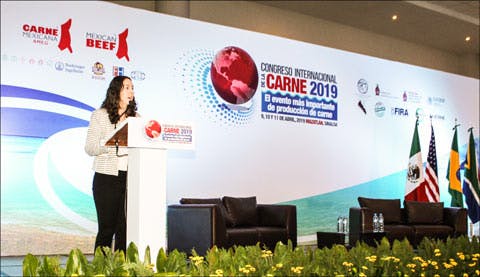Role of U.S. in Global Trade Highlighted at International Meat Congress in Mexico
Explaining how African Swine Fever (ASF) could drive record trade for pork and how China is positioned as the demand driver for both pork and beef, USMEF Trade Analyst Jessica Spreitzer presented “Global Red Meat Production and Trade Outlook” at the recent Mexican Cattle Feeders Association (AMEG) International Meat Congress in Mazatlan, Mexico.
Along with Spreitzer, USMEF was represented by Alejandra Valdez, technical services manager in Mexico.
The gathering, which included presentations by meat industry leaders and key government officials, continued to see a rise in the attendance of Mexican producers and international guests interested in learning more about international trade.
Spreitzer told the audience that the U.S. is well-positioned to fill the need for global demand for beef and pork. She noted that global pork supplies were abundant in 2018 as a result of producer profits in previous years that motivated increased production. However, shortages due to ASF in China and Vietnam are expected to cause a dramatic shift in pork supplies later this year.
“Looking at 2019, if we assume a 20% drop in China and Vietnam’s production levels as a result of ASF, that would be a 9% decrease in global production, a drop of 10 million metric tons – that is compared to about 12 million metric tons of total pork production per year in the U.S.,” Spreitzer noted. “China’s pork shortage alone will be larger than the volume of total global pork trade in 2019, and this shortage will drive global pork trade to a new record. Higher global pork prices will result in the rationing of consumption and drive expansion. From a production growth standpoint, the U.S. is the best positioned exporter to fill China’s pork shortage. However, the retaliatory tariffs on U.S. pork entering China will determine the extent to which the U.S. will supply China’s shortfall.”

USMEF Trade Analyst Jessica Spreitzer discusses global red meat production and trade at the Mexican Cattle Feeders Association International Meat Congress in Mazatlán, Mexico
Turning to beef, Spreitzer told the audience that global beef trade set a new record in both volume and value in 2018, driven largely by China’s buying but also by strong demand in Japan and South Korea. In 2018, beef exports to the China region were double that to the U.S., the next largest importer.
China accounted for 80% of the increase in 2018 global beef trade, and South America has been dominating China’s imports with about 70 percent market share, Spreitzer noted. China’s grain-fed beef imports accounted for 70,000 metric tons, or 6% of China’s total beef imports in 2018.
